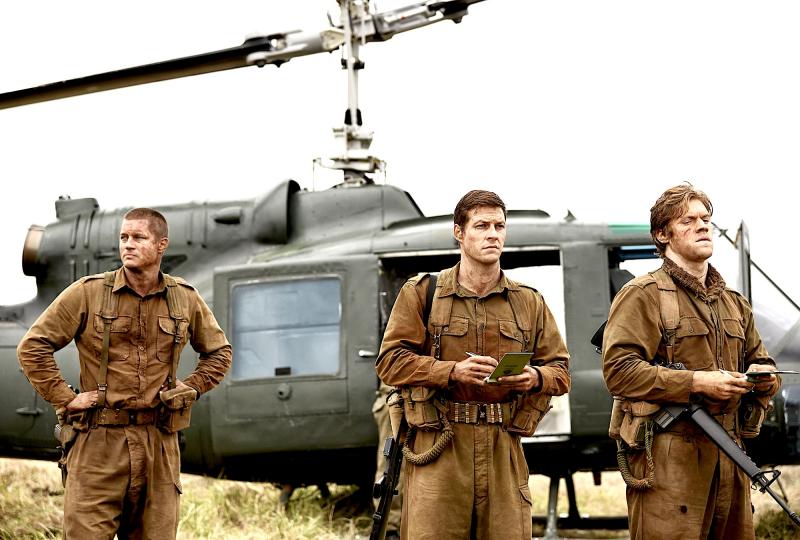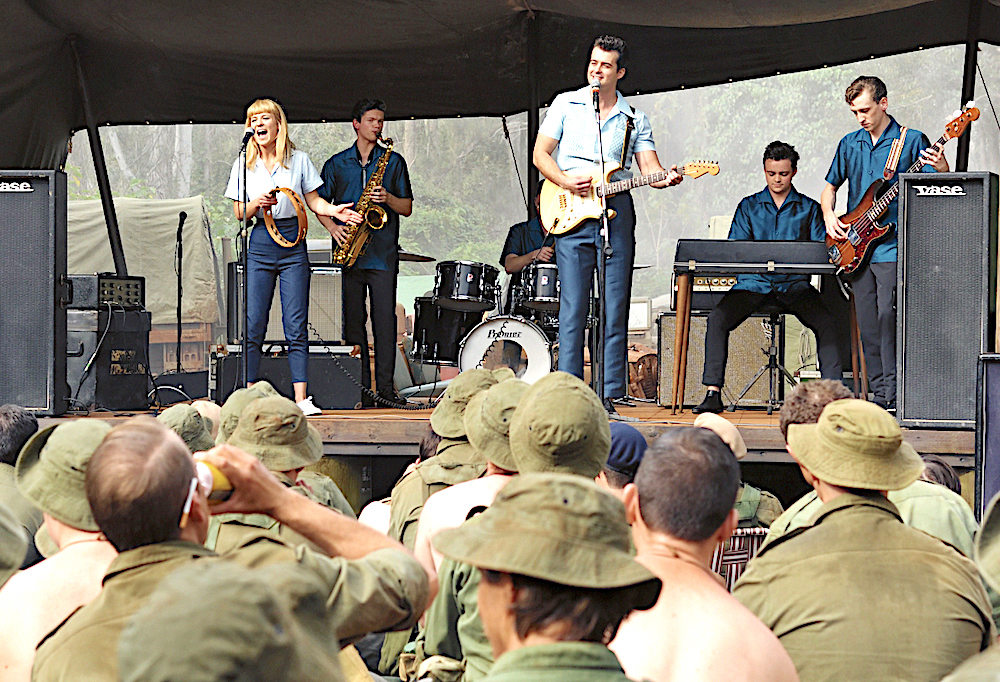Danger Close review - the Vietnam war from an Australian perspective | reviews, news & interviews
Danger Close review - the Vietnam war from an Australian perspective
Danger Close review - the Vietnam war from an Australian perspective
Punchy account of the short but ferocious battle of Long Tan

The battle of Long Tan in Vietnam isn’t well known to the casual observer, but it has entered the military folklore of Australia and New Zealand.
Kriv Stenders’s film tells the story with an unpretentious straightforwardness you wouldn’t get in a bigger-budget Hollywood production, even though the story isn’t dissimilar to the one told in the Mel Gibson vehicle We Were Soldiers – small unit goes out on patrol expecting to meet only limited opposition, then finds itself sucked into a horrific firestorm. The soldiers here were mostly young conscripts who’d rather have been anywhere else, and Stenders successfully manages to imbue them with distinct personalities which don’t descend into mere cliché. The most memorable of them is Private Paul Large, played by Daniel Webber with a cocky feistiness which grates on his hard-boiled commander Major Harry Smith (Travis Fimmel), a combat veteran who wants to be transferred to “real” soldiering with Special Forces.
It was perhaps inevitable that we’d see the early antagonism between Smith and Webber evolving into buddyhood in the stress of battle, but Danger Close fends off sentimentality with a pacy narrative which keeps the action sequences fierce and involving (the constant swoosh of passing bullets often makes you want to duck). The depiction of the conflicts between the headquarters officers overseeing the battle is also tensely portrayed, with frosty Brigadier Jackson (Richard Roxburgh) almost provoking a mutiny with his refusal to commit his armoured vehicles to rescue the beleaguered troops trapped in a rubber plantation and running out of ammo.
 Additional doffs of the hat are paid to the precision shooting of the artillery (“danger close” refers to the perilous tactic of firing shells that land only 50 yards from your own forces) and the helicopter pilots who flew at treetop height to drop ammunition to – in fact on – the Australians.
Additional doffs of the hat are paid to the precision shooting of the artillery (“danger close” refers to the perilous tactic of firing shells that land only 50 yards from your own forces) and the helicopter pilots who flew at treetop height to drop ammunition to – in fact on – the Australians.
However, the film has been criticised for its depiction of the Vietnamese as merely a faceless horde mostly there to be blown up or shot, while wider questions like what the hell the Australians were doing in America’s Vietnam war in the first place are not addressed. The politics are inevitably prickly, and part of the purpose of the film was to bring some recognition to the soldiers involved, since the Australian government spent 45 years not recognising that the Long Tan battle ever happened.
The way that times have changed is expressed to surprising effect in a scene where an Australian pop group, Col Joye & the Joy Boys with singer Little Pattie, fly in to play for the troops (pictured above). Their silly, naive surf-pop is the sound of a vanished world.
The future of Arts Journalism
You can stop theartsdesk.com closing!
We urgently need financing to survive. Our fundraising drive has thus far raised £49,000 but we need to reach £100,000 or we will be forced to close. Please contribute here: https://gofund.me/c3f6033d
And if you can forward this information to anyone who might assist, we’d be grateful.

Subscribe to theartsdesk.com
Thank you for continuing to read our work on theartsdesk.com. For unlimited access to every article in its entirety, including our archive of more than 15,000 pieces, we're asking for £5 per month or £40 per year. We feel it's a very good deal, and hope you do too.
To take a subscription now simply click here.
And if you're looking for that extra gift for a friend or family member, why not treat them to a theartsdesk.com gift subscription?
more Film
 The Mastermind review - another slim but nourishing slice of Americana from Kelly Reichardt
Josh O'Connor is perfect casting as a cocky middle-class American adrift in the 1970s
The Mastermind review - another slim but nourishing slice of Americana from Kelly Reichardt
Josh O'Connor is perfect casting as a cocky middle-class American adrift in the 1970s
 Springsteen: Deliver Me From Nowhere review - the story of the Boss who isn't boss of his own head
A brooding trip on the Bruce Springsteen highway of hard knocks
Springsteen: Deliver Me From Nowhere review - the story of the Boss who isn't boss of his own head
A brooding trip on the Bruce Springsteen highway of hard knocks
 The Perfect Neighbor, Netflix review - Florida found-footage documentary is a harrowing watch
Sundance winner chronicles a death that should have been prevented
The Perfect Neighbor, Netflix review - Florida found-footage documentary is a harrowing watch
Sundance winner chronicles a death that should have been prevented
 Blu-ray: Le Quai des Brumes
Love twinkles in the gloom of Marcel Carné’s fogbound French poetic realist classic
Blu-ray: Le Quai des Brumes
Love twinkles in the gloom of Marcel Carné’s fogbound French poetic realist classic
 Frankenstein review - the Prometheus of the charnel house
Guillermo del Toro is fitfully inspired, but often lost in long-held ambitions
Frankenstein review - the Prometheus of the charnel house
Guillermo del Toro is fitfully inspired, but often lost in long-held ambitions
 London Film Festival 2025 - a Korean masterclass in black comedy and a Camus classic effectively realised
New films from Park Chan-wook, Gianfranco Rosi, François Ozon, Ildikó Enyedi and more
London Film Festival 2025 - a Korean masterclass in black comedy and a Camus classic effectively realised
New films from Park Chan-wook, Gianfranco Rosi, François Ozon, Ildikó Enyedi and more
 After the Hunt review - muddled #MeToo provocation
Julia Roberts excels despite misfiring drama
After the Hunt review - muddled #MeToo provocation
Julia Roberts excels despite misfiring drama
 London Film Festival 2025 - Bradley Cooper channels John Bishop, the Boss goes to Nebraska, and a French pandemic
... not to mention Kristen Stewart's directing debut and a punchy prison drama
London Film Festival 2025 - Bradley Cooper channels John Bishop, the Boss goes to Nebraska, and a French pandemic
... not to mention Kristen Stewart's directing debut and a punchy prison drama
 Ballad of a Small Player review - Colin Farrell's all in as a gambler down on his luck
Conclave director Edward Berger swaps the Vatican for Asia's sin city
Ballad of a Small Player review - Colin Farrell's all in as a gambler down on his luck
Conclave director Edward Berger swaps the Vatican for Asia's sin city
 London Film Festival 2025 - from paranoia in Brazil and Iran, to light relief in New York and Tuscany
'Jay Kelly' disappoints, 'It Was Just an Accident' doesn't
London Film Festival 2025 - from paranoia in Brazil and Iran, to light relief in New York and Tuscany
'Jay Kelly' disappoints, 'It Was Just an Accident' doesn't
 Iron Ladies review - working-class heroines of the Miners' Strike
Documentary salutes the staunch women who fought Thatcher's pit closures
Iron Ladies review - working-class heroines of the Miners' Strike
Documentary salutes the staunch women who fought Thatcher's pit closures
 Blu-ray: The Man in the White Suit
Ealing Studios' prescient black comedy, as sharp as ever
Blu-ray: The Man in the White Suit
Ealing Studios' prescient black comedy, as sharp as ever

Add comment